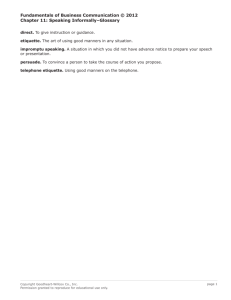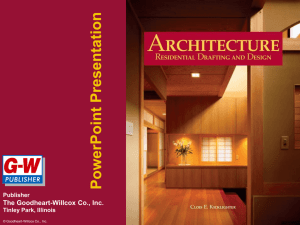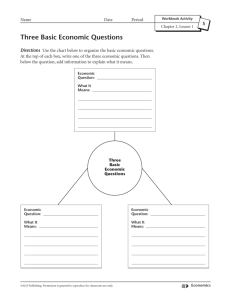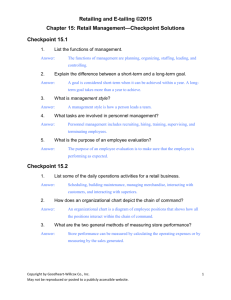Energy - TeacherWeb
advertisement
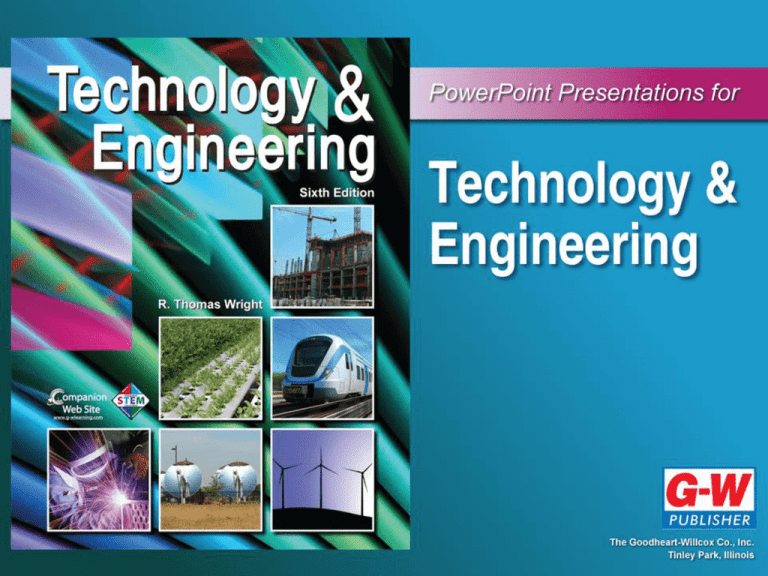
8 Applying Technology: Using Energy 27 Energy: The Foundation of Technology • • • • • Recall the definition of energy. Compare potential and kinetic energy. Compare energy, work, and power. Recall the six major forms of energy. Give examples of exhaustible, renewable, and inexhaustible energy sources. • Explain how energy technology can make our lives better and how energy technology can cause damage. © Goodheart-Willcox Co., Inc. Permission granted to reproduce for educational use only. Types of Energy • Energy is used in human tasks, like walking. • Kinetic energy is when a sail captures the wind to power a boat. • Potential energy is stored energy in a flashlight battery, a gallon of gasoline, etc. © Goodheart-Willcox Co., Inc. Permission granted to reproduce for educational use only. Measuring Work • Work is measured by multiplying the weight moved by the distance moved. • Force (Weight) x Distance = Foot-pounds (ft.-lbs.) • In the metric system, work is measured in joules (J). © Goodheart-Willcox Co., Inc. Permission granted to reproduce for educational use only. Measuring Power • Power = Work done (in ft.-lbs.) / Time (in seconds) • The metric version: • Power (in watts) = Work done (in joules) / Time (in seconds) © Goodheart-Willcox Co., Inc. Permission granted to reproduce for educational use only. Horsepower • Horsepower describes the output of many mechanical systems. • 1 Horsepower = 550 ft.-lbs./sec © Goodheart-Willcox Co., Inc. Permission granted to reproduce for educational use only. Types of Horsepower • An engine or motor rarely reaches its maximum or indicated horsepower. • Brake horsepower is delivered at the rear of an engine. • Drawbar horsepower is delivered to the hitch of tractors. • Frictional horsepower is the power needed to overcome the internal friction of the device. © Goodheart-Willcox Co., Inc. Permission granted to reproduce for educational use only. What is the difference between work and power? © Goodheart-Willcox Co., Inc. Permission granted to reproduce for educational use only. Wattage Rating • Wattage rating in an electrical apparatus: • P (power in watts) = I (current in amperes) x E (electromotive force in volts) • One kilowatt-hour is the work that 1000 watts will complete in one hour. © Goodheart-Willcox Co., Inc. Permission granted to reproduce for educational use only. Forms of Energy • There are six major forms of energy: © Goodheart-Willcox Co., Inc. Permission granted to reproduce for educational use only. Mechanical Energy • Mechanical energy is associated with machines. • Wind and moving water are also sources of mechanical energy. © Goodheart-Willcox Co., Inc. Permission granted to reproduce for educational use only. Radiant Energy • Electromagnetic waves produce radiant energy. • They range from long waves to short waves. • Cool objects give off longer waves than hot objects. • Low-frequency waves contain less energy than highfrequency waves of the same amplitude. © Goodheart-Willcox Co., Inc. Permission granted to reproduce for educational use only. Radiant Energy (Cont.) • Sources of radiant energy include: • The sun. • Objects heated with a flame. • A lightbulb in a lamp. • Examples of radiant energy: • • • • • Radio waves. Microwaves. Light. X rays. Gamma rays. © Goodheart-Willcox Co., Inc. Permission granted to reproduce for educational use only. Chemical Energy • Chemical energy is released • Sources of chemical when a substance is put energy: through a chemical reaction • Petroleum by rapid oxidation (burning), • Natural gas digestion, or reduction. • Coal • Wood • Grains • Biomass. © Goodheart-Willcox Co., Inc. Permission granted to reproduce for educational use only. Thermal Energy • Thermal energy cannot be seen directly, but is usually felt. • It is created by the rapid internal movement of atoms in a substance. • The energy strikes a surface and elevates its temperature. • It provides energy for heating systems and some electrical generating plants. © Goodheart-Willcox Co., Inc. Permission granted to reproduce for educational use only. Electrical Energy • Electrical energy is used as a basic source for other forms of energy. • It is often converted into heat energy or into light energy. • It is associated with electrons moving along a conductor (for example, a wire). • Lightning is a natural source of electrical energy. © Goodheart-Willcox Co., Inc. Permission granted to reproduce for educational use only. Nuclear Energy • Nuclear energy is released when atoms are split during fission or are combined during fusion. © Goodheart-Willcox Co., Inc. Permission granted to reproduce for educational use only. Energy Is Interrelated • All six forms of energy are related to one another. • Radiant energy can be used to produce heat. This is what happens when you get sunburned. • Fire causes fuel to undergo a chemical action. Coal can be turned into carbon dioxide and water. © Goodheart-Willcox Co., Inc. Permission granted to reproduce for educational use only. How many ways do we use electrical energy? © Goodheart-Willcox Co., Inc. Permission granted to reproduce for educational use only. Sources of Energy • There are three types of energy sources. (Marathon, U.S. Department of Energy) © Goodheart-Willcox Co., Inc. Permission granted to reproduce for educational use only. Exhaustible Energy Resources • Exhaustible energy resources cannot be replaced and have a limited supply on earth. • Include fossil fuels such as petroleum, natural gas, and coal. • Uranium, a radioactive mineral, is another exhaustible energy resource. © Goodheart-Willcox Co., Inc. Permission granted to reproduce for educational use only. Renewable Energy Resources • The supply of renewable energy resources is affected by human propagation, growing, and harvesting activities. • Biotechnology, such as gene modification, improves the types and quantities of resources grown. • Biomass materials can be used as energy resources and burned as biofuels or converted into methane to produce biogas. © Goodheart-Willcox Co., Inc. Permission granted to reproduce for educational use only. Inexhaustible Energy Resources • Inexhaustible energy resources are associated with the solar weather system: • One-third of the sun’s radiant energy that reaches the earth is reflected back into space. • About two-thirds of solar energy is absorbed by the atmosphere. • About one-fourth of this energy powers the water cycle. • Inexhaustible energy resources produce energy through hydroelectric power generators, wind generators, and solar converters. © Goodheart-Willcox Co., Inc. Permission granted to reproduce for educational use only. The Water Cycle © Goodheart-Willcox Co., Inc. Permission granted to reproduce for educational use only. Why is the water cycle important to energy conversion? © Goodheart-Willcox Co., Inc. Permission granted to reproduce for educational use only. Solar Energy and Wind • Solar energy heats the land. • Different amounts of solar energy strike various areas of the earth, creating temperature differences. • Warmer air rises and is replaced by cooler air. • This creates air movement, or wind. © Goodheart-Willcox Co., Inc. Permission granted to reproduce for educational use only. Geothermal Energy • Geothermal energy uses water that has been heated by the earth. • It is tapped by wells and used to heat buildings or power electrical generators. • The geysers at Yellowstone National Park are produced by geothermal energy. © Goodheart-Willcox Co., Inc. Permission granted to reproduce for educational use only. Effects of Energy Technology • People must look at both the good and bad effects of technology. • Fuels and biomatter burn, creating the power that drives our society, but releasing dangerous pollutants into the air, land, and water. • Nuclear power plants do not leak toxic gases, but their waste is more dangerous and longer lasting. © Goodheart-Willcox Co., Inc. Permission granted to reproduce for educational use only. • Power plant operators. • Control and monitor boilers, turbines, and generators in electrical powergenerating plants. • Monitor instruments to maintain voltage and regulate electricity flow. • Strong math and science background is required, as well as extensive on-the-job and classroom instruction. © Goodheart-Willcox Co., Inc. Permission granted to reproduce for educational use only. What is energy? The ability to do work. © Goodheart-Willcox Co., Inc. Permission granted to reproduce for educational use only. What is the difference between potential and kinetic energy? Potential energy is stored energy. Kinetic energy is energy in motion. © Goodheart-Willcox Co., Inc. Permission granted to reproduce for educational use only. How is power calculated? Power is calculated by dividing the work done by the time taken. © Goodheart-Willcox Co., Inc. Permission granted to reproduce for educational use only. What are the six major forms of energy? Mechanical, radiant, chemical, thermal, electrical, and nuclear. © Goodheart-Willcox Co., Inc. Permission granted to reproduce for educational use only. Give examples of exhaustible resources. Petroleum, natural gas, and uranium. © Goodheart-Willcox Co., Inc. Permission granted to reproduce for educational use only. Give examples of renewable resources. Wood, grains, and biomass resources (garbage, sewage, and waste). © Goodheart-Willcox Co., Inc. Permission granted to reproduce for educational use only. Give examples of inexhaustible resources. The water cycle, winds, direct solar energy, and geothermal energy. © Goodheart-Willcox Co., Inc. Permission granted to reproduce for educational use only. What are the beneficial and harmful effects of energy technology? Energy drives our society and produces the goods needed to survive. Technology can waste energy resources, pollute the atmosphere, and create human suffering. © Goodheart-Willcox Co., Inc. Permission granted to reproduce for educational use only.
